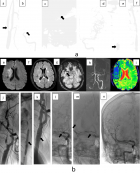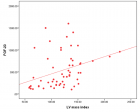Abstract
Research Article
Endovascular management of tandem occlusions in stroke: Treatment strategies in a real-world scenario
Juan J Cirio*, Celina Ciardi, Matias Lopez, Esteban V Scrivano, Javier Lundquist, Ivan Lylyk, Nicolas Perez and Pedro Lylyk
Published: 29 June, 2021 | Volume 5 - Issue 1 | Pages: 055-060
The association between intracranial large vessel occlusion (LVO) and concurrent steno-occlusive lesion of an ipsilateral extracranial internal carotid artery (ICA) is considered a tandem occlusion (TO) [1]. In approximately half of TO, the first clinical manifestation are acute occlusions of the extracranial ICA associated with occlusion of the middle cerebral artery (MCA), with additional occlusion of the intracranial ICA in up to 25% of these cases.[2] This particular lesion subset is technically challenging for endovascular treatment (EVT) and is also characterized by lower success rates of intravenous thrombolysis [3], worse prognosis compared to intracranial occlusions alone, and higher rates of symptomatic intracranial hemorrhage [4]. The optimal approach regarding EVT of TO remains controversial, and reports in this regard are scarce. There are two proposed strategies according to the selection of the first lesion to be treated. The proximal approach comprises stenting of the proximal cervical ICA followed by mechanical thrombectomy (MT) of the intracranial vessel, whereas the distal approach involves MT followed by stenting of the cervical ICA [3–14].
Besides, there other clinically relevant unresolved aspects regarding the treatment of these patients, such as concomitant use of intravenous thrombolysis, the need for stenting compared to angioplasty alone, as well as the most adequate antiplatelet strategy after treatment. Accordingly, we aimed to report the procedural and clinical outcomes of a real-world experience in a comprehensive stroke center regarding EVT of anterior circulation acute ischemic stroke (AIS) associated with a TO.
Read Full Article HTML DOI: 10.29328/journal.jnnd.1001051 Cite this Article Read Full Article PDF
Keywords:
Acute ischemic stroke; Tandem occlusion; Large vessel occlusion; Endovascular
References
- Gregory J, Poppe Alexandre Y, Marilyn L, Nicole D, Gioia Laura C, et al. Lack of Consensus Among Stroke Experts on the Optimal Management of Patients With Acute Tandem Occlusion. Stroke. 2019; 50: 1254–1256. PubMed: https://pubmed.ncbi.nlm.nih.gov/30890115/
- El-Mitwalli A, Saad M, Christou I, Malkoff M, Alexandrov AV. Clinical and sonographic patterns of tandem internal carotid artery/middle cerebral artery occlusion in tissue plasminogen activator-treated patients. Stroke. 2002; 33: 99–102. PubMed: https://pubmed.ncbi.nlm.nih.gov/11779896/
- Rangel-Castilla, L, Rajah GB, Shakir HJ, Shallwani H, Gandhi S, Davies JM, et al. Management of acute ischemic stroke due to tandem occlusion: Should endovascular recanalization of the extracranial or intracranial occlusive lesion be done first? Neurosurg Focus. 2017; 42: E16. PubMed: https://pubmed.ncbi.nlm.nih.gov/28366065/
- Heck DV, Brown MD. Carotid stenting and intracranial thrombectomy for treatment of acute stroke due to tandem occlusions with aggressive antiplatelet therapy may be associated with a high incidence of intracranial hemorrhage. J Neurointerve Sur. 2015 7: 170–175. PubMed: https://pubmed.ncbi.nlm.nih.gov/25387730/
- Spiotta AM, Lena J, Vargas J, Hawk H, Turner RD, et al. Proximal to distal approach in the treatment of tandem occlusions causing an acute stroke. J Neurointerve Surg. 2015; 7: 164–169. PubMed: https://pubmed.ncbi.nlm.nih.gov/24561885/
- Cohen JE, Gomori JM, Rajz G, Itshayek E, Eichel R, et al. Extracranial carotid artery stenting followed by intracranial stent-based thrombectomy for acute tandem occlusive disease. J NeuroInterve Surg. 2015; 7: 412–417. PubMed: https://pubmed.ncbi.nlm.nih.gov/24727131/
- Maurer CJ, Joachimski F, Berlis A. Two in One: Endovascular Treatment of Acute Tandem Occlusions in the Anterior Circulation. Clin Neuroradiol. 2015; 25: 397–402. PubMed: https://pubmed.ncbi.nlm.nih.gov/24988990/
- Puri AS, Kühn AL, Kwon HJ, Khan M, Hou SY, et al. Endovascular treatment of tandem vascular occlusions in acute ischemic stroke. J NeuroInterve Surg. 2015 7: 158–163. PubMed: https://pubmed.ncbi.nlm.nih.gov/24578485/
- Mpotsaris A, Bussmeyer M, Buchner H, Weber W. Clinical outcome of neurointerventional emergency treatment of extra- or intracranial tandem occlusions in acute major stroke: Antegrade approach with wallstent and solitaire stent retriever. Clin Neuroradiol. 2013; 23: 207–215. PubMed: https://pubmed.ncbi.nlm.nih.gov/23354342/
- Stampfl S, Ringleb PA, Möhlenbruch M, Hametner C, Herweh C, et al. Emergency Cervical Internal Carotid Artery Stenting in Combination with Intracranial Thrombectomy in Acute Stroke. Am J Neuroradiol. 2014; 35: 741–746. PubMed: https://pubmed.ncbi.nlm.nih.gov/24157733/
- Marnat G, Mourand I, Eker O, Machi P, Arquizan C, et al. Endovascular Management of Tandem Occlusion Stroke Related to Internal Carotid Artery Dissection Using a Distal to Proximal Approach: Insight from the RECOST Study. AJNR. Am J Neuroradiol. 2016; 37: 1281–1288. PubMed: https://pubmed.ncbi.nlm.nih.gov/26965467/
- Steglich-Arnholm H, Holtmannspötter M, Kondziella D, Wagner A, Stavngaard T, et al. Thrombectomy assisted by carotid stenting in acute ischemic stroke management: Benefits and harms. J Neurol. 2015; 262: 2668–2675. PubMed: https://pubmed.ncbi.nlm.nih.gov/26345413/
- Lockau H, Liebig T, Henning T, Neuschmelting V, Stetefeld H, et al. Mechanical thrombectomy in tandem occlusion: Procedural considerations and clinical results. Neuroradiology. 2015; 57: 589–598. PubMed: https://pubmed.ncbi.nlm.nih.gov/25404414/
- Lescher S, Czeppan K, Porto L, Singer OC, Berkefeld J. Acute stroke and obstruction of the extracranial carotid artery combined with intracranial tandem occlusion: Results of interventional revascularization. Cardiovascular Interventional Radiol. 2015; 38: 304–313. PubMed: https://pubmed.ncbi.nlm.nih.gov/25547082/
- Ferguson Gary G, Michael E, Barr Hugh WK, Patrick CG, Barnes Robert W, et al. The North American Symptomatic Carotid Endarterectomy Trial. Stroke. 1999; 30: 1751–1758. PubMed: https://pubmed.ncbi.nlm.nih.gov/10471419/
- Barber PA, Demchuk AM, Zhang J, Buchan AM. Validity and reliability of a quantitative computed tomography score in predicting outcome of hyperacute stroke before thrombolytic therapy. ASPECTS Study Group. Alberta Stroke Programme Early CT Score. Lancet (London, England). 2000; 355: 1670–1674. PubMed: https://pubmed.ncbi.nlm.nih.gov/10905241/
- Barber PA, Hill MD, Eliasziw M, Demchuk AM, Pexman JHW, et al. Imaging of the brain in acute ischaemic stroke: Comparison of computed tomography and magnetic resonance diffusion-weighted imaging. J Neurol. 2005; 76: 1528–1533. PubMed: https://pubmed.ncbi.nlm.nih.gov/16227545/
- Purushotham A, Campbell BCV, Straka M, Mlynash M, Olivot JM, et al. Apparent diffusion coefficient threshold for delineation of ischemic core. Int J Stroke: Official J Int Stroke Society. 2015; 10: 348–353. PubMed: https://pubmed.ncbi.nlm.nih.gov/23802548/
- Zaidat OO, Yoo AJ, Khatri P, Tomsick TA, von Kummer R, et al. Recommendations on angiographic revascularization grading standards for acute ischemic stroke: A consensus statement. Stroke. 2013; 44: 2650–2663. PubMed: https://pubmed.ncbi.nlm.nih.gov/23920012/
- Hacke W, Kaste M, Bluhmki E, Brozman M, Dávalos A, et al. Thrombolysis with alteplase 3 to 4.5 hours after acute ischemic stroke. New Engl J Med. 2008; 359: 1317–1329. PubMed: https://pubmed.ncbi.nlm.nih.gov/18815396/
- Jadhav AP, Zaidat OO, Liebeskind DS, Yavagal DR, Haussen DC, et al. Emergent Management of Tandem Lesions in Acute Ischemic Stroke. Stroke. 2019; 50: 428–433. PubMed: https://pubmed.ncbi.nlm.nih.gov/30580729/
- Grigoryan M, Haussen DC, Hassan AE, Lima A, Grossberg J, et al. Endovascular Treatment of Acute Ischemic Stroke Due to Tandem Occlusions: Large Multicenter Series and Systematic Review. Cerebrovascular Diseases (Basel, Switzerland). 2016; 41: 306–312. PubMed: https://pubmed.ncbi.nlm.nih.gov/26881779/
- Jovin TG, Chamorro A, Cobo E, de Miquel MA, Molina CA, et al. Thrombectomy within 8 Hours after Symptom Onset in Ischemic Stroke. New Engl J Med. 2015; 372: 2296–2306. PubMed: https://pubmed.ncbi.nlm.nih.gov/25882510/
- Gory B, Piotin M, Haussen DC, Steglich-Arnholm H, Holtmannspötter M, et al. Thrombectomy in Acute Stroke With Tandem Occlusions From Dissection Versus Atherosclerotic Cause. Stroke. 2017; 48: 3145–3148. PubMed: https://pubmed.ncbi.nlm.nih.gov/28974628/
- Goyal M, Menon BK, Zwam WH. van Dippel DWJ, Mitchell PJ, et al. Endovascular thrombectomy after large-vessel ischaemic stroke: A meta-analysis of individual patient data from five randomised trials. The Lancet. 2016; 387: 1723–1731. PubMed: https://pubmed.ncbi.nlm.nih.gov/26898852/
- Gory B, Haussen DC, Piotin M, Steglich-Arnholm H, Holtmannspötter M, et al. Impact of intravenous thrombolysis and emergent carotid stenting on reperfusion and clinical outcomes in patients with acute stroke with tandem lesion treated with thrombectomy: A collaborative pooled analysis. Eur J Neurol. 2018; 25: 1115–1120. PubMed: https://pubmed.ncbi.nlm.nih.gov/29575634/ B
- Sivan-Hoffmann R, Gory B, Armoiry X, Goyal M, Riva R, et al. Stent-Retriever Thrombectomy for Acute Anterior Ischemic Stroke with Tandem Occlusion: A Systematic Review and Meta-Analysis. European Radiology. 2017; 27: 247–254. PubMed: https://pubmed.ncbi.nlm.nih.gov/27085698/
- Zinkstok SM, Roos YB. Early administration of aspirin in patients treated with alteplase for acute ischaemic stroke: A randomised controlled trial. The Lancet. 2012: 380: 731–737. PubMed: https://pubmed.ncbi.nlm.nih.gov/22748820/
- Papanagiotou P, Haussen DC, Turjman F, Labreuche J, Piotin M, et al. Carotid Stenting With Antithrombotic Agents and Intracranial Thrombectomy Leads to the Highest Recanalization Rate in Patients With Acute Stroke With Tandem Lesions. JACC. Cardiovascular Interventions. 2018; 11: 1290–1299. PubMed: https://pubmed.ncbi.nlm.nih.gov/29976365/
Figures:

Figure 1

Figure 2
Similar Articles
-
Analysis of early Versus Delayed Carotid Surgery after Acute Ischemic StrokePEROU Sébastien*,DETANTE Olivier,SPEAR Rafaelle,PIRVU Augustin,ELIE Amandine,MAGNE Jean-Luc. Analysis of early Versus Delayed Carotid Surgery after Acute Ischemic Stroke. . 2017 doi: 10.29328/journal.jnnd.1001001; 1: 001-011
-
Endovascular treatment experience in acute ischemic strokeİbrahim Acır*,Vildan Yayla,Hacı Ali Erdoğan. Endovascular treatment experience in acute ischemic stroke. . 2021 doi: 10.29328/journal.jnnd.1001047; 5: 026-028
-
Endovascular management of tandem occlusions in stroke: Treatment strategies in a real-world scenarioJuan J Cirio*,Celina Ciardi,Matias Lopez,Esteban V Scrivano,Javier Lundquist,Ivan Lylyk,Nicolas Perez,Pedro Lylyk. Endovascular management of tandem occlusions in stroke: Treatment strategies in a real-world scenario. . 2021 doi: 10.29328/journal.jnnd.1001051; 5: 055-060
Recently Viewed
-
Agriculture High-Quality Development and NutritionZhongsheng Guo*. Agriculture High-Quality Development and Nutrition. Arch Food Nutr Sci. 2024: doi: 10.29328/journal.afns.1001060; 8: 038-040
-
A Low-cost High-throughput Targeted Sequencing for the Accurate Detection of Respiratory Tract PathogenChangyan Ju, Chengbosen Zhou, Zhezhi Deng, Jingwei Gao, Weizhao Jiang, Hanbing Zeng, Haiwei Huang, Yongxiang Duan, David X Deng*. A Low-cost High-throughput Targeted Sequencing for the Accurate Detection of Respiratory Tract Pathogen. Int J Clin Virol. 2024: doi: 10.29328/journal.ijcv.1001056; 8: 001-007
-
A Comparative Study of Metoprolol and Amlodipine on Mortality, Disability and Complication in Acute StrokeJayantee Kalita*,Dhiraj Kumar,Nagendra B Gutti,Sandeep K Gupta,Anadi Mishra,Vivek Singh. A Comparative Study of Metoprolol and Amlodipine on Mortality, Disability and Complication in Acute Stroke. J Neurosci Neurol Disord. 2025: doi: 10.29328/journal.jnnd.1001108; 9: 039-045
-
Development of qualitative GC MS method for simultaneous identification of PM-CCM a modified illicit drugs preparation and its modern-day application in drug-facilitated crimesBhagat Singh*,Satish R Nailkar,Chetansen A Bhadkambekar,Suneel Prajapati,Sukhminder Kaur. Development of qualitative GC MS method for simultaneous identification of PM-CCM a modified illicit drugs preparation and its modern-day application in drug-facilitated crimes. J Forensic Sci Res. 2023: doi: 10.29328/journal.jfsr.1001043; 7: 004-010
-
A Gateway to Metal Resistance: Bacterial Response to Heavy Metal Toxicity in the Biological EnvironmentLoai Aljerf*,Nuha AlMasri. A Gateway to Metal Resistance: Bacterial Response to Heavy Metal Toxicity in the Biological Environment. Ann Adv Chem. 2018: doi: 10.29328/journal.aac.1001012; 2: 032-044
Most Viewed
-
Evaluation of Biostimulants Based on Recovered Protein Hydrolysates from Animal By-products as Plant Growth EnhancersH Pérez-Aguilar*, M Lacruz-Asaro, F Arán-Ais. Evaluation of Biostimulants Based on Recovered Protein Hydrolysates from Animal By-products as Plant Growth Enhancers. J Plant Sci Phytopathol. 2023 doi: 10.29328/journal.jpsp.1001104; 7: 042-047
-
Sinonasal Myxoma Extending into the Orbit in a 4-Year Old: A Case PresentationJulian A Purrinos*, Ramzi Younis. Sinonasal Myxoma Extending into the Orbit in a 4-Year Old: A Case Presentation. Arch Case Rep. 2024 doi: 10.29328/journal.acr.1001099; 8: 075-077
-
Feasibility study of magnetic sensing for detecting single-neuron action potentialsDenis Tonini,Kai Wu,Renata Saha,Jian-Ping Wang*. Feasibility study of magnetic sensing for detecting single-neuron action potentials. Ann Biomed Sci Eng. 2022 doi: 10.29328/journal.abse.1001018; 6: 019-029
-
Pediatric Dysgerminoma: Unveiling a Rare Ovarian TumorFaten Limaiem*, Khalil Saffar, Ahmed Halouani. Pediatric Dysgerminoma: Unveiling a Rare Ovarian Tumor. Arch Case Rep. 2024 doi: 10.29328/journal.acr.1001087; 8: 010-013
-
Physical activity can change the physiological and psychological circumstances during COVID-19 pandemic: A narrative reviewKhashayar Maroufi*. Physical activity can change the physiological and psychological circumstances during COVID-19 pandemic: A narrative review. J Sports Med Ther. 2021 doi: 10.29328/journal.jsmt.1001051; 6: 001-007

HSPI: We're glad you're here. Please click "create a new Query" if you are a new visitor to our website and need further information from us.
If you are already a member of our network and need to keep track of any developments regarding a question you have already submitted, click "take me to my Query."
















































































































































